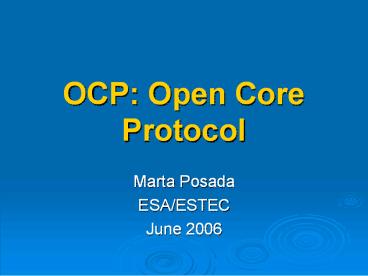OCP: Open Core Protocol - PowerPoint PPT Presentation
Title:
OCP: Open Core Protocol
Description:
SOC designers want to reuse IP cores to shorten development schedules. ... Burst allow target to know there are more transfers coming for pre-fetching ... – PowerPoint PPT presentation
Number of Views:1251
Avg rating:3.0/5.0
Title: OCP: Open Core Protocol
1
OCP Open Core Protocol
- Marta Posada
- ESA/ESTEC
- June 2006
2
Motivation
- SOC designers want to reuse IP cores to shorten
development schedules. - Problem IP cores need to be re-adapted into each
system design - Motivation reuse without rework
- Plug-and-play between cores and interconnects
systems from different sources.
3
What is needed?
- What is required is a standard, well-defined
protocol for cores to talk to a system
interconnect.
4
OPEN CORE PROTOCOL 2.0
- Point-to-point, uni-directional, synchronous
- Easy physical implementation
- Master/Slave, Request/Response model
- Well-defined, simple roles
- Extensions
- Added functionality to support cores with more
complex interface requirements - Configurability
- Match a cores requirements exactly
- Tailor design to required features only
5
OPEN CORE PROTOCOL 2.0
- OCP is configurable to tailor the interface
exactly to the features required by the core - Basic OCP is very simple
- Many extensions exist for cores with more complex
interface requirements - OCP is configured via a set of parameters
- Control the presence of a set of signals
- example core makes use of byte enables
- Control the width of a set of signals
- example address width is 14 bits
- Control protocol features
- example core uses data handshaking to pipeline
write data
6
BASIC OCP INTERFACE
7
COMUNICATION PHASES
8
SIMPLE EXTENSION
- Byte enables
- Provide byte addressing capability on a
multi-byte interface - Multiple address spaces, mapped at non contiguous
address ranges. Typically to - Differentiate core registers from core memory
space - Differentiate cores within a sub system
- Custom in-band signaling
- To any of the transfer phases Request, response,
datahandshake - Typical usage Cache signaling,
application/emulation qualifier, dynamic
endianness qualifier
9
BURST EXTENSION(I)
- Multiple independent OCP transfers can be linked
together into a single burst transaction. - Burst allow target to know there are more
transfers coming for pre-fetching - Use of burst can greatly improve overall system
performance
10
OCP BURST EXTENSION(II)
- Ability to handle precise bursts (the length is
known) and un-precise bursts (the length is
unknown). - Ability to specify standard address sequences
(incrementing, wrapping, streaming, XOR) as well
as custom address sequences. - Ability to support single request/multiple data
transaction models. - Ability to define atomic sub-units within a burst
for fine control of the request interleaving
throughout the system interconnect. - Ability to add complete framing information with
all transfer phases.
11
OCP THREAD EXTENSION
- Within an OCP thread, responses must return in
the order of the requests. - For some cores, out-of-order responses are
desirable - A multi-bank DRAM controller can return requests
to an open bank faster than to a closed one - A DMA controller can handle multiple outstanding
transactions from multiple channels on the same
OCP port - An OCP interface can support multiple threads
- Allows for concurrency and out-of-order returns
- Each thread retains strict ordering semantics
- BUT there are is no ordering between transfers
in different threads
12
SIDEBAND SIGNALS
- Reset
- Interrupt
- Transaction error reporting
- Core Flags (core-to-core)
- Core Status/Control (system-to-core)
- Test
13
Converting Existing Cores to OCP
- Determine the OCP characteristics that the core
will have - Design conversion logic to wrap the core
- Describes the cores interface and timing
constraints - Develop a portable testbench for the core
- If the core is synthesizable, develop a
technology-independent synthesis script for it - Assemble the core, modelsm documentation and
package
14
CORE CONVERSION
- Know the native core interface
- Know OCP
- Build bridge
- Test
- Package OCP core
15
OCP CORE BRIDGE
- Match OCP configurations to native protocol
patterns. - Chose the kind of socket ? Master or Slave
- Choose the interface signals
- - Choose the simplest configuration that meets
the functional and performance requirements of
the core - Develop the bridge logic to convert core signals
into OCP signals
16
Case of Study CAN CORE
- CAN (Control Area Network) is a serial
communications protocol which supports
distributed real time control with a very high
level of security. - We are going to convert CAN Core 5.1 (developed
by ESA) to OCP. - Interface CAN
17
Case of study CAN CORE
- OCP BRIDGE
- We are going to design a SLAVE OCP socket
- OCP Burst Extension, with single request multiple
data. - OCP Word 1 byte (8 bits)
- Commands Idle (IDLE), Write (WR) and Read (RD)
- Responses Null (NULL), Data Valid (DVA) and
Error (ERR).
18
Case of study CAN CORE
- OCP INTERFACE
19
Case of study CAN CORE
- CAN TO OCP
- Model inspired in HurryAmba (developed by ESA).
- The CAN core signals are going to be store in
some registers. - Both CAN and OCP bridge have access to the
registers - Pooling to know there are received data in the
registers
20
Case of study CAN CORE
- TIMING DIAGRAMS. Write operation
21
Case of study CAN CORE
- TIMING DIAGRAMS. Read operation































